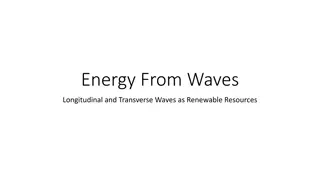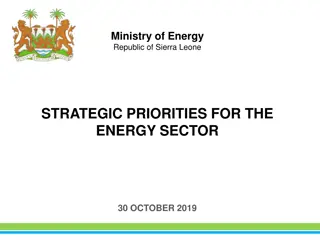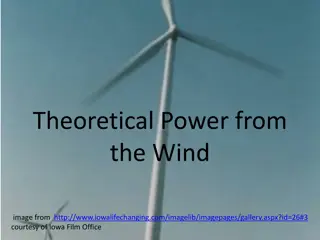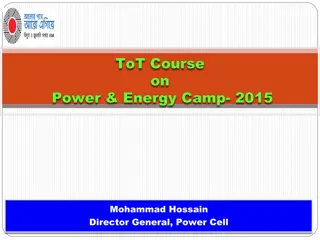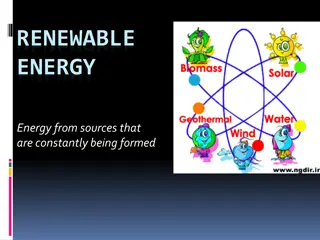Overview of Power Systems and Energy Generation
The power system encompasses generation, distribution, and transmission systems that convert various forms of energy, such as coal and diesel, into electrical energy. Energy cannot be created or destroyed but can only be transformed from one form to another. Generation involves converting primary energy sources like the sun, wind, water, fuels, and nuclear energy into electricity. Basic operations in power systems include load flow, fault studies, protection, stability, insulation, coordination, economic dispatch, power quality, and more. Steam power stations, utilizing the heat energy of coal combustion, play a crucial role in electricity production due to their efficiency.
Download Presentation

Please find below an Image/Link to download the presentation.
The content on the website is provided AS IS for your information and personal use only. It may not be sold, licensed, or shared on other websites without obtaining consent from the author.If you encounter any issues during the download, it is possible that the publisher has removed the file from their server.
You are allowed to download the files provided on this website for personal or commercial use, subject to the condition that they are used lawfully. All files are the property of their respective owners.
The content on the website is provided AS IS for your information and personal use only. It may not be sold, licensed, or shared on other websites without obtaining consent from the author.
E N D
Presentation Transcript
BINESWAR BRAHMA ENGINEERING COLLEGE DEPARTMENT OF ELECTRICAL ENGINEERING POWER SYSTEM-I BISWANATH HAJOARY Asst. Professor Department of electrical Engineering
POWER SYSTEM Definition: The power system is a network which consists generation, distribution and transmission system. It uses the form of energy (like coal and diesel) and converts it into electrical energy.
Energy cannot be created nor be destroyed but can only be converted from one form of energy to another form of energy .
GENERATION Generation is the production of electricity at power stations or generating units where a form of primary energy is converted into electricity. These sources of energy are : (i) The Sun (ii) The Wind (iii) Water (iv) Fuels (v) Nuclear energy.
BASIC OPERATION REQUIRED FOR THE POWER SYSTEM Load flow Fault studies Protection Earthing Stability Insulation Coordination Economic dispatch Power Quality Electromagnetic Combability, EMC Load Forecasting
Steam Power Station (Thermal Station) A generating station which converts heat energy of coal combustion into electrical energy is known as a steam power station. A steam power station basically works on the Rankine cycle. Steam is produced in the boiler by utilizing the heat of coal combustion. The steam is then expanded in the prime mover (i.e., steam turbine) and is condensed in a condenser to be fed into the boiler again. The steam turbine drives the alternator whichh converts mechanical energy of the turbine into electrical energy.
Advantages (i) The fuel (i.e., coal) used is quite cheap. (ii) Less initial cost as compared to other generating stations. (iii) It can be installed at any place irrespective of the existence of coal. The coal can be transported to the site of the plant by rail or road. (iv) It requires less space as compared to the hydroelectric power station. (v) The cost of generation is lesser than that of the diesel power station. Disadvantages (i) It pollutes the atmosphere due to the production of large amount of smoke and fumes. (ii) It is costlier in running cost as compared to hydroelectric plant.
Steam generating plant. The steam generating plant consists of a boiler for the production of steam and other auxiliary equipment for the utilisation of flue gases. (i) Boiler. The heat of combustion of coal in the boiler is utilised to convert water into steam at high temperature and pressure. (ii) Superheater. The steam produced in the boiler is wet and is passed through a superheater where it is dried and superheated (i.e., steam temperature increased above that of boiling point of water) by the flue gases on their way to chimney. Superheating provides two principal benefits. Firstly, the overall efficiency is increased. Secondly, too much condensation in the last stages of turbine (which would cause blade corrosion) is avoided. The superheated steam from the superheater is fed to steam turbine through the main valve. (iii) Economizer. An economiser is essentially a feed water heater and derives heat from the flue gases for this purpose. The feed water is fed to the economizer before supplying to the boiler. The economiser extracts a part of heat of flue gases to increase the feed water temperature. (iv) Air preheater. An air preheater increases the temperature of the air supplied for coal burning by deriving heat from flue gases. Air is drawn from the atmosphere by a forced draught fan and is passed through air preheater before supplying to the boiler furnace. The air preheater extracts heat from flue gases and increases the temperature of air used for coal combustion. The principal benefits of preheating the air are : increased thermal efficiency and increased steam capacity per square metre of boiler surface.
steam Power plant 3. Steam turbine. The dry and superheated steam from the superheater is fed to the steam turbine through main valve. 4. Alternator. The steam turbine is coupled to an alternator. The alternator converts mechanical energy of turbine into electrical energy. 5. Feed water. The condensate from the condenser is used as feed water to the boiler. 6. Cooling arrangement. In order to improve the efficiency of the plant, the steam exhausted from the turbine is condensed* by means of a condenser. Water is drawn from a natural source of supply such as a river, canal or lake and is circulated through the condenser. The circulating water takes up the heat of the exhausted steam and itself becomes hot. This hot water coming out from the condenser is discharged at a suitable location down the river. In case the availability of water from the source of supply is not assured throughout the year, cooling towers are used.
Choice of Site for Steam Power Stations (i) Supply of fuel. (ii) Availability of water. (iii) Transportation facilities. (iv) Cost and type of land. (v) Nearness to load centres. (vi) Distance from populated area.
Hydro-electric power stations In a hydro-electric power station, water head is created by constructing a dam across a river or lake. From the dam, water is led to a water turbine. The water turbine captures the energy in the falling water and changes the hydraulic energy (i.e., product of head and flow of water) into mechanical energy at the turbine shaft. The turbine drives the alternator which converts mechanical energy into electrical energy.
Hydro-electric power stations Advantages (i) It requires no fuel as water is used for the generation of electrical energy. (ii) It is quite neat and clean as no smoke or ash is produced. (iii) It requires very small running charges because water is the source of energy which is available free of cost. (iv) It is comparatively simple in construction and requires less maintenance. (v) It does not require a long starting time like a steam power station. In fact, such plants can be put into service instantly. (vi) It is robust and has a longer life. (vii) Such plants serve many purposes. In addition to the generation of electrical energy, they also help in irrigation and controlling floods. (viii) Although such plants require the attention of highly skilled persons at the time of construction, yet for operation, a few experienced persons may do the job well.
Hydro-electric power stations Disadvantages (i) It involves high capital cost due to construction of dam. (ii) There is uncertainty about the availability of huge amount of water due to dependence on weather conditions. (iii) Skilled and experienced hands are required to build the plant. (iv) It requires high cost of transmission lines as the plant is located in hilly areas which are quite away from the consumers.
Choice of Site for Hydro-electric Power Stations (i) Availability of water. (ii) Storage of water. (iii) Cost and type of land. (iv) Transportation facilities.
Diesel Power Station A generating station in which diesel engine is used as the prime mover for the generation of electrical energy is known as diesel power station. In a diesel power station, diesel engine is used as the prime mover. Advantages (i) The design and layout of the plant are quite simple. (ii) It occupies less space as the number and size of the auxiliaries is small. (iii) It can be located at any place. (iv) It can be started quickly and can pick up load in a short time. (v) There are no standby losses. (vi) It requires less quantity of water for cooling. (vii) The overall cost is much less than that of steam power station of the same capacity. (viii) The thermal efficiency of the plant is higher than that of a steam power station. (ix) It requires less operating staff.
Disadvantages (i) The plant has high running charges as the fuel (i.e., diesel) used is costly. (ii) The plant does not work satisfactorily under overload conditions for a longer period. (iii) The plant can only generate small power. (iv) The cost of lubrication is generally high. (v) The maintenance charges are generally high.
Diesel Power Station Advantages (i) The design and layout of the plant are quite simple. (ii) It occupies less space as the number and size of the auxiliaries is small. (iii) It can be located at any place. (iv) It can be started quickly and can pick up load in a short time. (v) There are no standby losses. (vi) It requires less quantity of water for cooling. (vii) The overall cost is much less than that of steam power station of the same capacity. (viii) The thermal efficiency of the plant is higher than that of a steam power station. (ix) It requires less operating staff.
Transmission System Electric power transmission is the bulk movement of electrical energy from a generating site, such as a power plant, to an electrical substation. The interconnected lines which facilitate this movement are known as a transmission network.
Classification of Overhead Transmission Lines A transmission line has three constants R, L and C distributed uniformly along the whole length of the line. The overhead transmission lines are classified as : Short transmission line The line length is up to 60 km and the line voltage is comparatively low less than 20KV. Medium transmission line The line length is between 60 km to 160 km and the line voltage is between 20kV to 100kV. Long transmission line The line length is more than 160 km and the line voltage is high greater than 100KV performance of transmission line can be determined by its efficiency and voltage regulation.
AC vs DC Transmission Fundamentally there are two systems by which electrical energy can be transmitted: 1.High voltage DC electrical transmission system. 2.High AC electrical transmission system. Advantage of using DC transmission Only two conductors are required. DC transmission systems have reduced insulation costs. Inductance, capacitance, phase displacement and surge problems can be eliminated in DC system
Disadvantage of DC transmission The alternating voltages can easily be stepped up and down, which is not possible in DC transmission system. Maintenance of AC substation is quite easy and economical compared to DC. The transforming of power in AC electrical substation is much easier than motor-generator sets in a DC system.
But AC transmission system also has some disadvantages, including: The volume of conductor required in AC systems is much higher when compared to DC systems. The reactance of the line affects the voltage regulation of the electrical power transmission system. Problems of skin effects and proximity effects only found in AC systems. AC transmission systems are more likely to be affected by corona discharge than a DC transmission system. Construction of AC electrical power transmission network is more complicated than DC systems.
Distribution the distribution system is the electrical system between the sub-station fed by the transmission system and the consumers meters. It generally consists of feeders, distributors and the service mains.
basic layout interconnected power system network diagram












